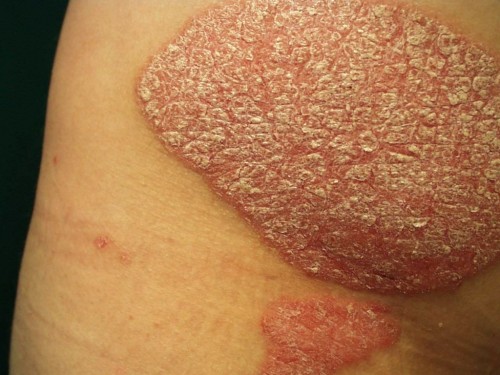‘Vulgaris’ literal meaning is ‘common’. The most common form of the skin disease psoriasis is termed as psoriasis vulgaris. This type of psoriasis is found in about 80% of the people suffering from this disease. The other medical term used for this condition is Plaque Psoriasis as it is characterized by well demarcated plaques of inflamed skin that can appear on any part of the body which includes most commonly scalp, elbows, knees or trunk. At the top of the plaques, the flaky silvery white scales are present. Most common symptoms include itching, pain and cracking of the affected skin.
Causes of Psoriasis Vulgaris
Psoriasis is an autoimmune disorder mediated by T cells. T cells produced cytokines which further stimulate proliferation of keratinocytes to the epidermis resulting in the development of this disease. These interactions are stimulated by multiple factors like environmental or genetic factors. The cytokines also lead to the production of antigenic adhesion molecules in vascular structures which further increase T-cell cytokine response.
Symptoms of Psoriasis Vulgaris
- Well defined and sharply demarcated raised bumps with size of one to several centimetres.
- Presence of thin, dry and silvery scales on the top of plaques.
- Inflammation and pruritus of the affected skin.
- Lesions are fiery red in colour and when present on the lower part like flexor surface of legs, lesions appear as blue or violaceous tint in colour.
- Involvement of nails as nails exhibit pitting, onycholysisor oil-drop sign.
- Psoriatic arthritis occurs in 10-20% of all people suffering from psoriasis characterized by inflamed, warm and tender joints.
- In children, plaque psoriasis exhibit different lesion as the lesions exhibit less scales and plaques are also not as think as in adults.
Management of Psoriasis Vulgaris
- Topical treatment: Use of corticosteroids, anthralin, coal tar, tazarotene is advisable to get relief from the symptoms.
- Photo therapy: It includes the following treatment:
- Ultraviolet B radiation: there is less chances of burning and offers efficient results. The combination of topical treatment and narrow band UVB radiation is given to the patient as second line of treatment.
- Psoralen plus Ultraviolet a irradiation (PUVA) in combination with UVA radiation a photosensitizing drug methoxsalen (8-methoxypsoralen) is given in this treatment to deal with severe cases.
- Biologic treatment: It includes selective systematic derived intervention to treat the patients at the molecular level.Use of efalizumab,adalimumab, ustekinumab, etanercept is advisable in biological treatment. This treatment is recommended for the patient with severe disease and when the former treatments are unsuccessful. This treatment acts on the pathogenesis of this disease.
Complications of Psoriasis Vulgaris
- Complications of psoriasis vulgaris include psychosocial distress and anxiety due to embarrassment and self-consciousness about appearance of skin.
- The skin disease severely affects the quality of life of the patients.
- Also use of topical treatment for longer time can lead to the development of erythrodermic and pustular form of psoriasis.

